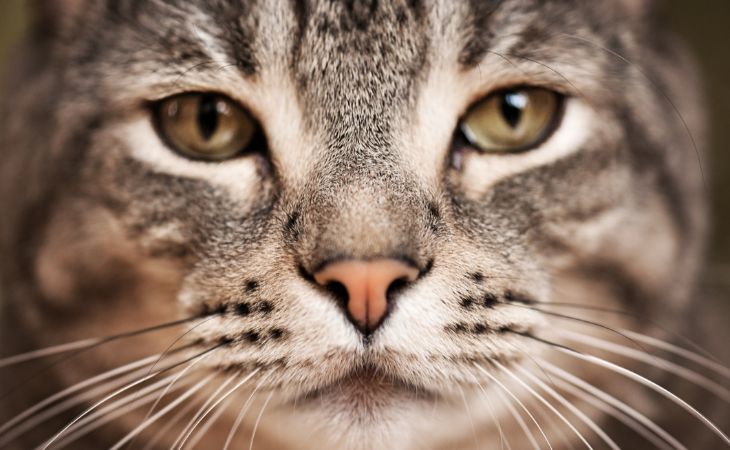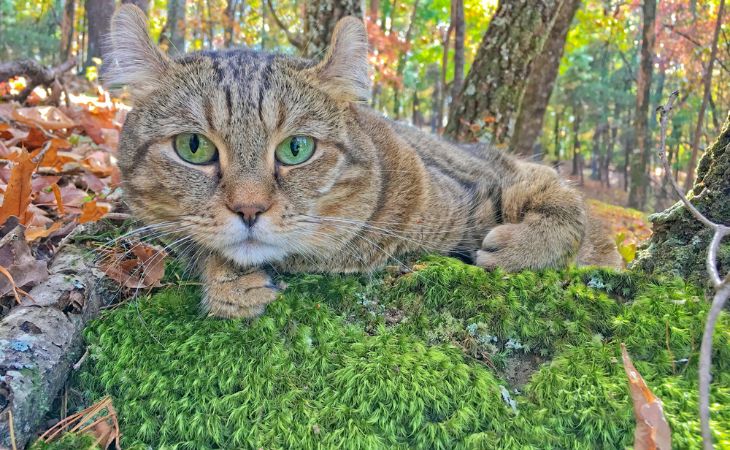Breed: Highlander | Size: Large | Average lifespan: 15+ years | Temperament: Gentle and affectionate | Coat length: Short and medium-long | Origin: United States.
The Highlander cat is a rare and little-known cat breed that is definitely worth looking into. Behind this cat’s imposing façade is actually an incredibly gentle and affectionate cat. In this article, we will give you an overview of the Highlander cat’s origins, character, physical characteristics, and grooming needs.
The origins of the Highlander cat
A very new cat breed
The Highlander cat is a very new cat breed. They first appeared in 1995, in the United States. More precisely, they appeared in North Carolina at the Timberline Cattery, which is now closed. It wasn’t until 2008 that The International Cat Association recognized the breed.
There are very few breeders in Europe. Most of the Highlander cat breeds are located in the United States and in Canada.
A mix of two breeds with strong characteristics
While the lineage of the Highlander cat possesses the genes of numerous breeds (Manx, Pixie-bob, American Bobtail, Maine Coon and Bengal) used early on when the breed was being created, the Highlander cat is mainly a cross between two types of cats: the caracal and the Jungle Curl. It was the Jungle Curl that gave this breed their famous and recognizable ears. Highlander cat breeders wanted to create a domestic cat with the appearance of a wild cat. The Jungle Curl being itself a cross between a domestic cat and a jungle cat (a cat that is considered to be a wild feline and not considered a cat breed). With their curled ears and their imposing stature, the Highlander cat has lived up to the expectations of breeders.
The Highlander cat’s character
This cat breed is certainly one of the most affectionate cats that can develop very close bonds with humans. In fact, it is often said that the Highlander cat is a dog in a cat’s body.
A large cat with a lot of qualities
This is an easy-going cat that is well-suited to many different ways of life. With that being said, they need to see the world and love meeting new people. This feline enjoys interacting with those around them, most particularly their family, other cats, and other animals in the household. They can easily get used to living with a dog and enjoy sharing toys with them.
The Highlander cat is easy to care for and does not impose many constraints on the daily lives of their owners.
Their gentle character and bond with humans makes this cat perfect for families.
A large cat with a gentle heart
The Highlander cat is a lively cat that can get along easily with other animals and children. Behind their wild façade is a very affectionate cat that needs to create a stable and intense bond with their owner. They follow their owners everywhere, like dogs, and are perfect for people who are having a hard time choosing between a cat and a dog. While they appreciate play time, they love cuddling with their owner during long naps.
A very protective companion
Just like dogs can be, this cat is very protective of those around them. It is, therefore, important to be careful when there are new people and animals present in their living environment.
This feline needs a lot of attention and time from their owner. This must be taken into account when considering adopting a Highlander cat, so that you can ensure that they are living wholly and happily.
Also, be careful, because of this cat’s rarity, these cats can be a source of envy. Because of this, they can be stolen. For this reason, it’s best to make sure that your cat has been identified.

The physical characteristics of the Highlander cat
General
This is a large cat, with a muscular physique, and large chest. That is what gives this cat a wild appearance. Their curled ears are also very recognizable. The Highlander cat is polydactyl and has large paws. Their tail is short and thick, even though certain litters can have kittens with tails that are of normal length. All colors are recognized. The coat is short to medium-long.
Head
Highlander cats have a rather large and square muzzle and curved ears. The ears stretch out at around 10-12 weeks, before adopting their definitive curve.
Body
This is a cat with a powerful musculature and physique that seems to be adapted to life in the wild. As these cats are big, they can look imposing.
Coat, color, and grooming
Coat
The coat of this cat is typically short to medium-long. Their coat is rather soft and easy to brush.
Colors
There are an infinite amount of colors and patterns that the Highlander cat can have. Nevertheless, the most common are cats with patterned tan coats.
The other colors that Highlander cats can be colors such as ebony, blue, chocolate, lilac, red, cream, silver, and sepia. Some of the patterns that Highlander cats can have are tabby and marbled. Because there are so many colors and patterns, each and every Highlander cat is unique!
The Highlander cat’s grooming needs
Grooming the fur of this large feline does not present any particular difficulties. Brushing this cat weekly to get rid of dead fur allows this cat to keep their soft and shiny coat.
However, their unique ears need special care. Washing them weekly is necessary to keep them healthy. Even though the mutation of their unique ear shape does not seem to have caused any diseases, the breed is still too new for the information about their ears to be sufficient. The same goes for this cat’s toes, as the Highlander cat is polydactyl, regular care for their claws and buying a good cat tree is essential.
Did you know?
It is said that this cat lives in “never-ending childhood”! They can spend hours playing, preferably with their owner. As they very intelligent, they like to learn, try to understand their environment, and those who live in it. They are curious and always on the search for new discoveries. In addition, they communicate a lot with their owner and can be very expressive.
The Highlander cat’s favorite game is fetch. They can spend infinite amounts of time playing this.
The Highlander cat at a glance
Size: up to 40 cm (≈ 15.7 in).
Weight: 7 to 9 kg (≈ 15.4 to 19.8 lb).
Health: because the breed is still very new, we are yet not aware of any specific diseases. Nevertheless, it is important to protect this cat from common diseases like feline coryza. They seem to also be sensitive to gingivitis and conjunctivitis.
Average lifespan: 10 years.
Are Highlander cats good with children? Yes, this is an ideal cat for families with children. Their gentle and affectionate character makes them bond quickly with others. They appreciate playing with children daily, and will voluntarily cuddle with them during calmer moments. As these cats are playful, sociable, and patient, they are wonderful cats for children.

